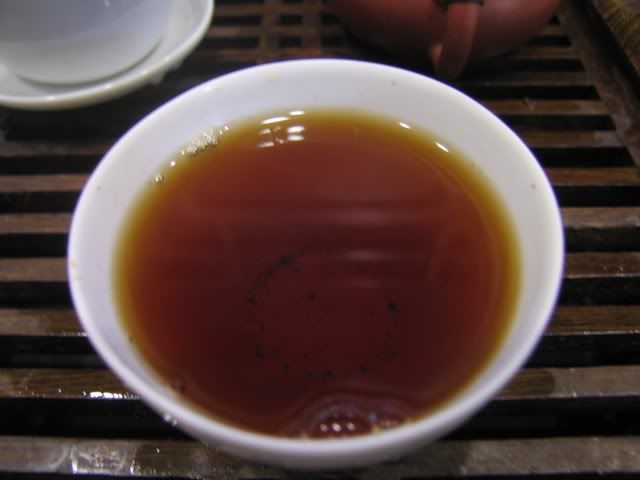This tea looked pretty

I bought it today at a shop near where I was running an errand. It’s one of those grandpa shops — looks awful inside, and has lots (I mean lots) of random stuff accumulated over time. I figured they might have some old stock of oolongs — and they do. There are two, and I bought a bit of both. The shop owner said this tea is 30 years, and it sells at a moderately high price. I didn’t buy the 30 years claim, but the tea is oh so beautiful. It’s a rich, dark red, shiny, oily… looks great. The tight rolling perhaps indicates a later date than the “30 years” claim. That’s not a real concern.
It yielded a dark liquor as well

It’s thick, it’s aromatic, it’s got a good finish. The problem is… the tea is sour 🙁
It’s not deadly, because the sourness comes on later, and isn’t the all-powering, all-covering sort of sour. Instead, it’s just somewhat sour, and the sourness happens when the tea (liquid) has had a little time to cool down. When piping hot, just out of the gaiwan, the tea is not sour at all. After a sip or two, it starts showing up. When cooled down further, the sourness is more apparent. I am not sure the reason why that would be the case, but …. it’s what I found.
It’s a shame, because otherwise the tea exhibits good aged qualities, but I don’t think it is nearly as aged as 30 years. The tea itself was pretty high grade, and tastes that way with enough complexity. Sourness could be due to a few things, but it generally has to do with moisture, or so I was told. This is perhaps fixable with some proper treatment in the roaster, because the sourness does go away after a while. If I brew the tea lightly, it might not even show up at all. In fact, that’s I think how I’m going to drink the rest of this — brewed light, maybe even in a cup with water added, and see how it turns out. In a gaiwan with a heavy hand, it’s not pleasant enough, certainly not for the price.
This is what the tea looks like when wet…. still beautiful

Compare it to yesterday’s cheap baozhong

You can see there’s a difference in the hue of the leaves, and obviously, baozhongs are not tightly rolled like this tea today. Still… in terms of aged oolong, this one has failed.

 RSS - Posts
RSS - Posts
11 responses so far ↓
MANDARINstea // October 12, 2007 at 8:09 pm |
These 30 years old looking too shiny?
MarshalN // October 12, 2007 at 11:49 pm |
Hey, long time no see!
I never thought this is 30 years…. they’ll be lucky to be around 10
Anonymous // October 13, 2007 at 1:03 am |
I was told once that an anitique tea loses its sourness after 15 years. Maybe you are right about it being closer to 10 years old.
Anonymous // October 13, 2007 at 2:28 am |
Hi lz .. again supporting the old adage: “taste and try before you buyâ€
Never the less I feel your disappointment, all the attributes of being a good tea, only to be disappointed. john
MarshalN // October 13, 2007 at 3:48 am |
Carnie — are you referring to oolongs or puerh? Sounds like the person who told you that was referring to puerh? I don’t think oolongs lose their sourness.
John — I know, but circumstances meant I didn’t have any time…
Anonymous // October 13, 2007 at 4:05 am |
That person is talking about oolong. I trust what he said because the he let me try some oolong that he kept for 15- 20 years.
MarshalN // October 13, 2007 at 5:04 am |
Hmmm, interesting, are those roasted every few years, or does he just keep them?
Anonymous // October 13, 2007 at 5:37 am |
He does both I believe. I am in the process of attaining some of this tea. I have tried some of the ’83 dong ding oolong from redcircletea.com. Check it out for the tatste profile.
MarshalN // October 13, 2007 at 5:47 am |
Interesting, you’re the same Carnie as the one on the website, I’d imagine? I’ve found aged oolongs to be impossible to judge in quality without trying it out in person. Aged-ness as well as potential problems (most often sourness) are undetectable unless one tries it out.
The picture for the green “Yiwu” on the website is obviously not the right one…
Anonymous // October 13, 2007 at 6:08 am |
The Yiwu picture is just stock picture which will be replace soon I hope; the web master is being diffcult.
I agree with you that you should try all teas before you buy it. ( Sometimes this is impossible. )
Age oolong is very hard to find and a lot of time people give you a run for your money. I was told by my teacher that the sourness will fade over time. He said the sourness will disappear around 15- 20 years. I hope this helps.
MarshalN // October 13, 2007 at 6:17 am |
I’ve just never heard that theory before, so I’d be a little cautious… from what others have said, sourness usually comes from it being too moist, and the tea develops that sour note. Personal expeirence has confirmed at least that part. Re-roasting it will help get rid of it, but if a tea is too sour, even roasting won’t fix it and it’s basically done. I don’t think anybody I know have heard of the sourness going away at around 15-20 years…. not that your teacher is wrong, mind you, just that I haven’t heard, which is why I asked if he re-roasts the teas he’s talking about or not.